
Pulley
A single fixed pulley changes the direction of force only and in general assumed to be massless and frictionless.
It is clear from the example given below.
Ex. A bucket of mass $25 \mathrm{~kg}$ is raised by a $50 \mathrm{~kg}$ man in two different ways as shown in fig. What is the action on the floor by the man in the two cases? If the floor yields to a normal force of 700 N, which mode should the man adopt to lift the bucket without the floor yielding?
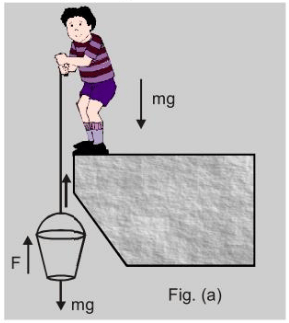 Sol. Here, mass of the bucket, $m=25 \mathrm{~kg} ;$ mass of the man, $M=50 \mathrm{~kg}$
Sol. Here, mass of the bucket, $m=25 \mathrm{~kg} ;$ mass of the man, $M=50 \mathrm{~kg}$
Force applied to lift the bucket, $\mathrm{F}=\mathrm{mg}=25 \times 9.8=245 \mathrm{~N}$
Weight of the man, $\mathrm{Mg}=50 \times 9.8=490 \mathrm{~N}$
Fig. (a) When the bucket is raised by the man by applying force $F$ in upward direction, reaction equal and opposite to $F$
will act on the floor in addition to the weight of the man.
Therefore, action on the floor $=\mathrm{Mg}+\mathrm{F}=490+245=735 \mathrm{~N}$
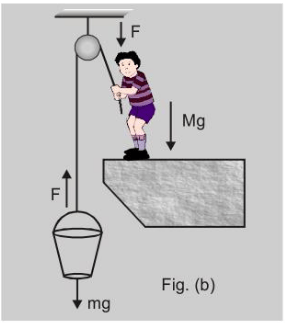 Fig. (b) When the bucket is raised by the man by applying force $F$ over the rope (passed over the pulley) in downward
direction, reaction equal and opposite to $F$ will act on the floor.
Fig. (b) When the bucket is raised by the man by applying force $F$ over the rope (passed over the pulley) in downward
direction, reaction equal and opposite to $F$ will act on the floor.
Therefore, action on the floor $=\mathrm{Mg}-\mathrm{F}=490-245=245 \mathrm{~N}$
Since the floor yields to a normal force of $700 \mathrm{~N}$.
The mode (b) should be adopted by the man to lift the bucket.
Case I
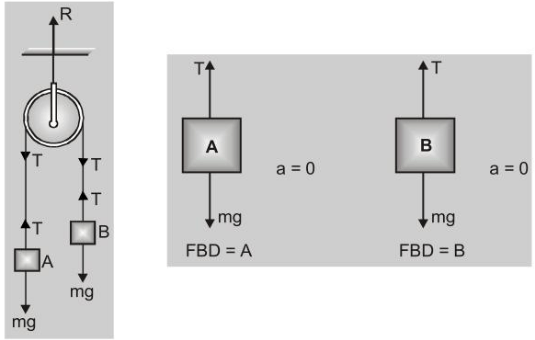 $m_{1}=m_{2}=m$
$m_{1}=m_{2}=m$
Tension in the string $\mathrm{T}=\mathrm{mg}$
Acceleration ' $a$ ' = zero.
Reaction at the pulley
$\mathrm{R}=2 \mathrm{~T}=2 \mathrm{mg}$
[Strength of support or suspension]
Case II
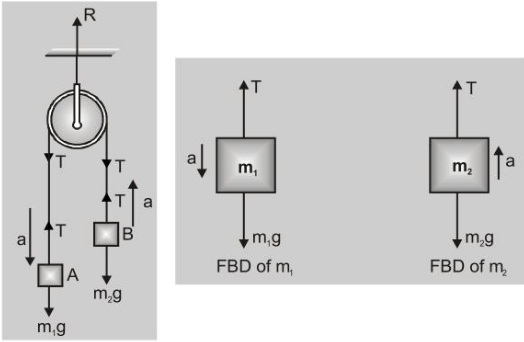 $m_{1}>m_{2}$
$m_{1}>m_{2}$
for mass $m_{1}, \quad m_{1} g-T=m_{1} a \ldots \ldots$ ....(i)
for mass $m_{2}, \quad T-m_{2} g=m_{2} a \ldots \ldots$ .....(ii)
Solving, we get
$a=\left(\frac{m_{1}-m_{2}}{m_{1}+m_{2}}\right) g$
or $\quad T=\frac{\left(2 m_{1} m_{2}\right) g}{\left(m_{1}+m_{2}\right)}$
reaction at the pulley $R=2 T=\frac{4 m_{1} m_{2} g}{\left(m_{1}+m_{2}\right)}$
Case III
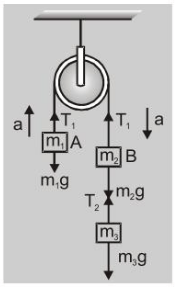 The forces acting on the system are shown in the fig.
The forces acting on the system are shown in the fig.
For mass $m_{1}: \quad T_{1}-m_{1} g=m_{1} a \quad \ldots \ldots \ldots$ ......(i)
For mass $m_{2}: \quad m_{2} g+T_{2}-T_{1}=m_{2} a$ ........(ii)
For mass $m_{3}: m_{3} g-T_{2}=m_{3} a$ .......(iii)
Solving these equations, we get $a=\left(\frac{m_{2}+m_{3}-m_{1}}{m_{1}+m_{2}+m_{3}}\right) g$
Putting the value of 'a' in equation (i) and (iii) tension $\mathrm{T}_{1}$ and $\mathrm{T}_{2}$ can be calculated.
Alternative Method :
$\mathrm{T}_{1}=\mathrm{m}_{1}(\mathrm{~g}+\mathrm{a})$ .......(1) $\left(T_{1}=\right.$ effective weight of $\left.m_{1}\right)$
$T_{1}=\left(m_{2}+m_{3}\right)(g-a)$ .......(2) $\left(T_{1}=\right.$ effective weight of $\left.m_{2}+m_{3}\right)$
$\mathrm{T}_{2}=\mathrm{m}_{3}(\mathrm{~g}-\mathrm{a})$ .......(3) $\left(T_{2}=\right.$ effective weight of $\left.m_{3}\right)$
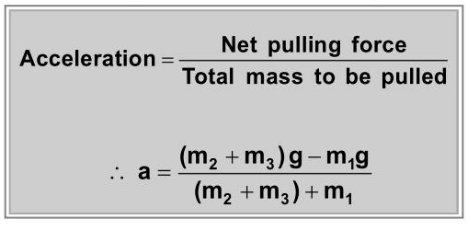 eq $^{n} .(1)$ and $e q^{n} .(2)$ gives us
eq $^{n} .(1)$ and $e q^{n} .(2)$ gives us
$m_{1} g+m_{1} a=\left(m_{2}+m_{3}\right) g-\left(m_{2}+m_{3}\right) a$
$\left(m_{1}+m_{2}+m_{3}\right) a=\left(m_{2}+m_{3}-m_{1}\right) g$
$a=\left(\frac{m_{2}+m_{3}-m_{1}}{m_{1}+m_{2}+m_{3}}\right) g$ ......(4)
From $\mathrm{eq}^{\mathrm{n}} \cdot(1)$ and $\mathrm{eq}^{\mathrm{n}} .$ (4)
$\mathrm{T}_{1}=\mathrm{m}_{1} \mathrm{~g}\left\{1+\frac{\mathrm{m}_{2}+\mathrm{m}_{3}-\mathrm{m}_{1}}{\mathrm{~m}_{1}+\mathrm{m}_{2}+\mathrm{m}_{3}}\right\} \quad \mathrm{T}_{1}=\frac{2 \mathrm{~m}_{1}\left(\mathrm{~m}_{2}+\mathrm{m}_{3}\right)}{\mathrm{m}_{1}+\left(\mathrm{m}_{2}+\mathrm{m}_{3}\right)} \mathrm{g}$
$\mathrm{T}_{2}=\mathrm{m}_{3} \mathrm{~g}\left\{1-\frac{\left(\mathrm{m}_{2}+\mathrm{m}_{3}-\mathrm{m}_{1}\right)}{\mathrm{m}_{1}+\mathrm{m}_{2}+\mathrm{m}_{3}}\right\}=\frac{2 \mathrm{~m}_{1} \mathrm{~m}_{3}}{\mathrm{~m}_{1}+\mathrm{m}_{2}+\mathrm{m}_{3}}$
Ex. Three equal weights A, B, C of mass $2 \mathrm{~kg}$ each are hanging on a string passing over a fixed frictionless pulley as shown in fig. below. Find out tension in the string connecting weights $B$ and $C$.
Sol. $\quad T=2 m(g-a)$ effective weight of $m_{2}$
$\mathrm{T}=\mathrm{m}(\mathrm{g}+\mathrm{a})$ effective weight of $m_{1}$
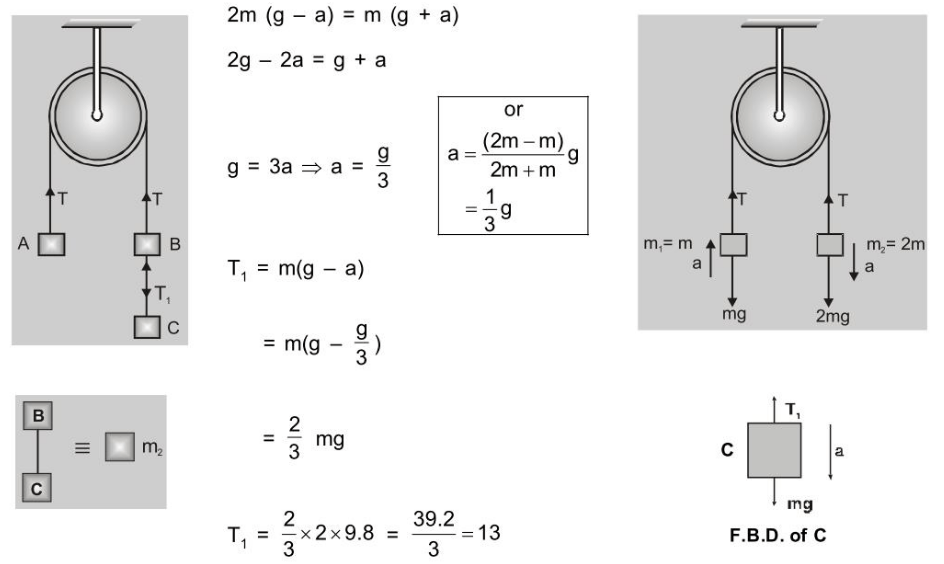
Case IV
(a) Without friction :
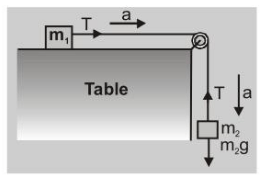 For mass $m_{1}: T=m_{1} a$
For mass $m_{1}: T=m_{1} a$
for mass $m_{2}: m_{2} g-T=m_{2} a$
Solving, we get
Acceleration $a=\frac{m_{2} g}{\left(m_{1}+m_{2}\right)}$
$\mathrm{T}=\frac{\mathrm{m}_{1} \mathrm{~m}_{2} \mathrm{~g}}{\left(\mathrm{~m}_{1}+\mathrm{m}_{2}\right)}$
(b) With friction : (Friction in bet". surface and block)
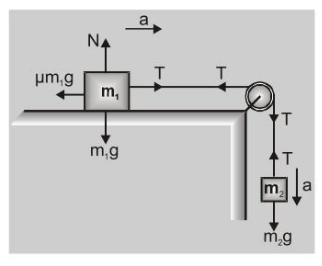 For mass $m_{1}: T-\mu m_{1} g=m_{1} a$
For mass $m_{1}: T-\mu m_{1} g=m_{1} a$
For mass $m_{2}: m_{2} g-T=m_{2} a$
Solving, we get
Acceleration $\quad \mathrm{a}=\frac{\left(\mathrm{m}_{2}-\mu \mathrm{m}_{1}\right) \mathrm{g}}{\left(\mathrm{m}_{1}+\mathrm{m}_{2}\right)}$
$\mathrm{T}=\frac{\mathrm{m}_{1} \mathrm{~m}_{2}(1+\mu) \mathrm{g}}{\left(\mathrm{m}_{1}+\mathrm{m}_{2}\right)}$
Case V
$\left(m_{1}>m_{2}\right)$
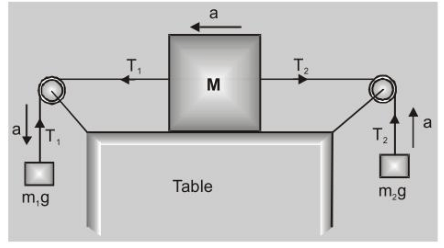 $\mathrm{m}_{1} \mathrm{~g}-\mathrm{T}_{1}=\mathrm{m}_{1} \mathrm{a} \quad \ldots \ldots$ (i)
$\mathrm{m}_{1} \mathrm{~g}-\mathrm{T}_{1}=\mathrm{m}_{1} \mathrm{a} \quad \ldots \ldots$ (i)
$\mathrm{T}_{2}-\mathrm{m}_{2} \mathrm{~g}=\mathrm{m}_{2} \mathrm{a}$
$\mathrm{T}_{1}-\mathrm{T}_{2}=\mathrm{Ma}$
Solving (i), (ii) and (iii), we get
$a=\frac{\left(m_{1}-m_{2}\right) g}{\left(m_{1}+m_{2}+M\right)}$
$\mathrm{T}_{1}=\mathrm{m}_{1} \mathrm{~g}\left[\frac{2 \mathrm{~m}_{2}+\mathrm{M}}{\mathrm{m}_{1}+\mathrm{m}_{2}+\mathrm{M}}\right], \quad \mathrm{T}_{2}=\mathrm{m}_{2} \mathrm{~g}\left[\frac{2 \mathrm{~m}_{1}+\mathrm{M}}{\mathrm{m}_{1}+\mathrm{m}_{2}+\mathrm{M}}\right]$
Also Read
JEE Physics Notes
To watch Free Learning Videos on JEE by Kota’s top IITian Faculties Install the eSaral App
